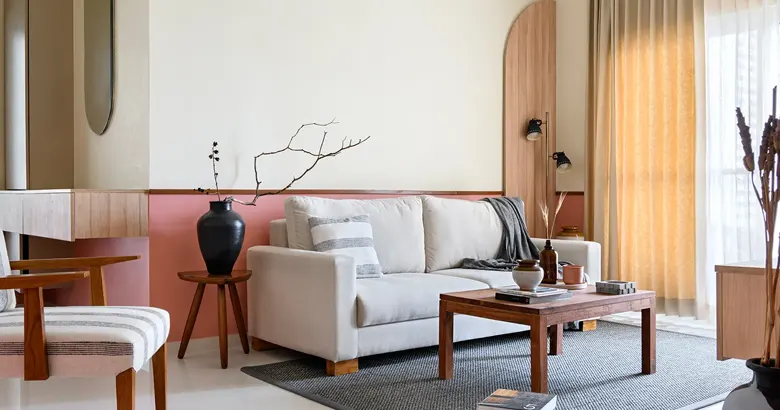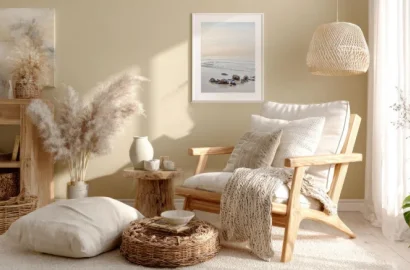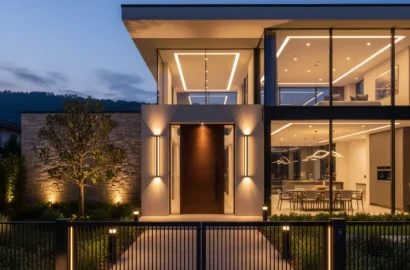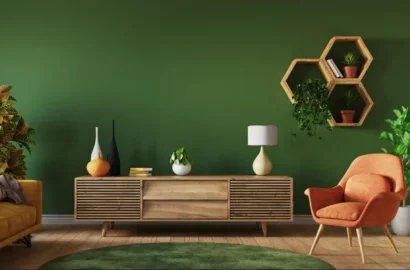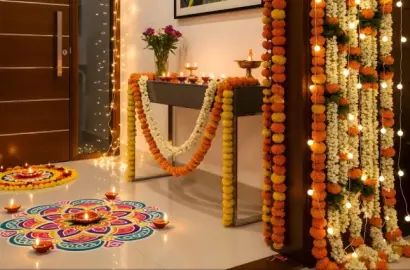Looking for functional and chic small living room interior design ideas in 2024? Explore the guiding principles and a list of clever ideas that can help you create the living room of your dreams.
If you’re struggling to decorate the interiors of your small living room and are unsure about furniture selection, color schemes, and furnishings, this guide is here to help you.
Most people undermine the potential of small living rooms, especially when it comes to access and maintenance. The real challenge lies in aesthetics, and this guide has all the solutions you need to create a space that is not only functional but also visually pleasing.
Let’s start with the principles of interior design for small living rooms and then move on to exploring ideas and tips for your designs or homes.
Here’s a clickable list of everything that we’ll be covering in this article!
Contents:
- Principles of Interior Design for Small Living Rooms
- 25 Small Living Room Interior Design Ideas
- Conclusion
Principles of Interior Design for Small Living Rooms
Compact living rooms come with limited functional space and can present significant challenges. However, a well-designed living room layout with some smart styling can feel just as comfortable and visually attractive as a larger space. Here are some principles you can follow to make this happen.
1. Create Open Floor Plans
Open plans integrate different functional areas into one without solid partition walls while ensuring comfortable movement. An open kitchen-living-dining space can work brilliantly for small apartment living rooms. Combining a home office setup with your living room is another interesting layout that can work in your favor without making you feel like you’re missing out on sufficient space.
2. Design Multifunctional Spaces
When space is limited, rooms can be designed to serve multiple functions, making the most of every square foot. A small living room with a sofa cum bed can be great for accommodating guests, while an open kitchen with an island can function as a great breakfast corner. Convenient pull-out or foldable units, like wall-mounted folding dining tables and desks, can add versatility to multifunctional units without taking up extra floor space and maximizing efficiency.
3. Balance Scale & Proportion
In small living rooms, the visual impact of furniture can differ greatly compared to larger rooms. Careful planning and selection of every piece is a must to balance the scale and proportion of the room. Placing bigger furniture along the perimeter of the room frees up the central space, adding pops of color as accents create visual balance, mirrors can create the illusion of a larger space, and incorporating corner shelves and cabinets can effectively use blank walls and maintain a clutter-free look.
4. Maximise Available Space
In small living rooms, it's wise to optimize available space by implementing creative storage solutions like display racks, built-in storage, shoe racks and corner cabinets. This ensures that you utilize every inch of your home while keeping it stylish.

25 Small Living Room Interior Design Ideas That Will Maximise the Tiniest of Spaces
Living rooms that are small in size can be big in style with thoughtful and forward-thinking planning. Here are some practical and simple ideas that will push you to rethink your living room design, ensuring it is comfortable, convenient, and highly aesthetic:
1. Go With White Walls

Image Courtesy: Good Housekeeping
Opt for an all-white wall theme in your small living room and experience how this incredibly simple idea can become one of the most effective design choices you’ll ever make. White walls provide you with a blank canvas where you can put up your artwork and decor pieces to customize your space while also making the room look spacious. Pair these walls with light furniture, bright pops of color, patterns or textures, and create a comfortable and chic living room that reflects your taste.
2. Maintain the Room’s Architecture

Image Courtesy: Architectural Digest
When it comes to choosing the interior design style, furniture and decor, plan your interiors as per the existing architecture of the room. If you have a living room that has windows on either side, creating symmetry, take that as your cue and maintain a sense of balance throughout your design. Alternatively, if your room has a curved wall, pick a curved sofa to match the space and choose other elements that harmonize with this feature.
3. Paint Your Ceilings

Image Courtesy: The Spruce
Paint your fifth wall—ceiling, in a lighter shade compared to that of the walls and experience how much of a difference it can make. By doing so, your ceiling will create an illusion of increased height, making the living room feel more spacious and lighter.
4. Pick a Sectional Sofa With Exposed Legs

Image Courtesy: The Spruce
Choose a compact sectional sofa with exposed legs, ensuring it sits perfectly in your living room without blocking movement. Then, upholster it in a vibrant fabric for visual appeal. Bulkier furniture tends to make a small space feel more cramped, but the legs of a sofa elevate the piece off the floor, allowing you to see the floor and creating the illusion of a more open and spacious room. Additionally, it lets light filter underneath, enhancing the room through reflections.
5. Opt for Multifunctional Furniture
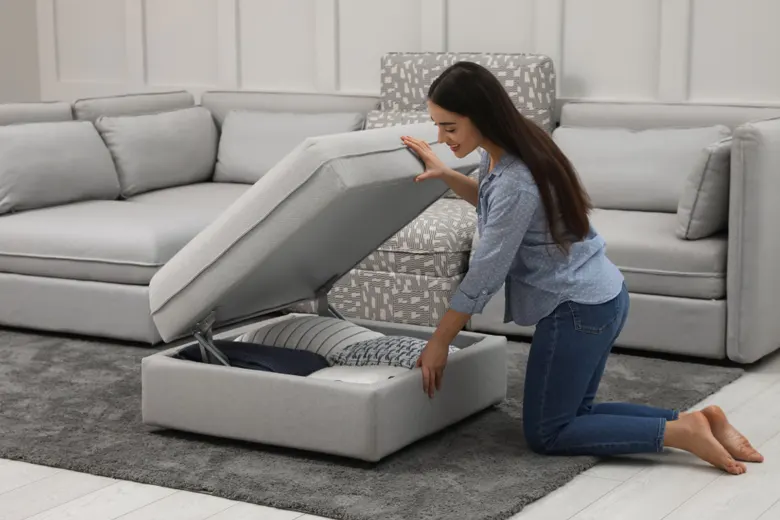
Image Courtesy: Living Designs Furniture
When space is limited, multifunctional furniture pieces come in handy. Invest in a sofa cum bed with storage, a sturdy pouf that can store your items and also be used as an extra seating option if they are too many guests, or even a coffee table or ottomans that come with storage, maximizing functionality.
6. Prioritise Concealed Storage
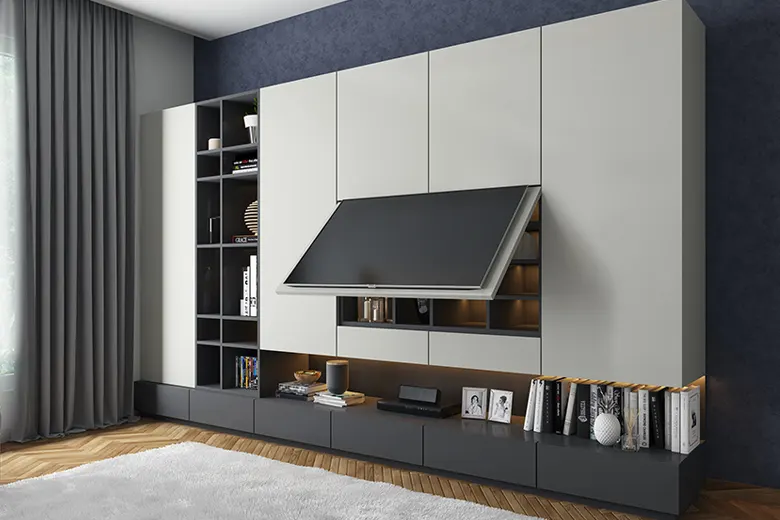
Image Courtesy: Design Cafe
Incorporate concealed storage such as ottomans, coffee tables, and benches with hidden compartments to stash away items and maintain a neat appearance. Install built-in shelving units and maximize vertical wall space for shelves to increase storage capacity without taking up floor space. With that, also consider media consoles and cabinets that can conceal electronics and media equipment.
7. Utilise Corners
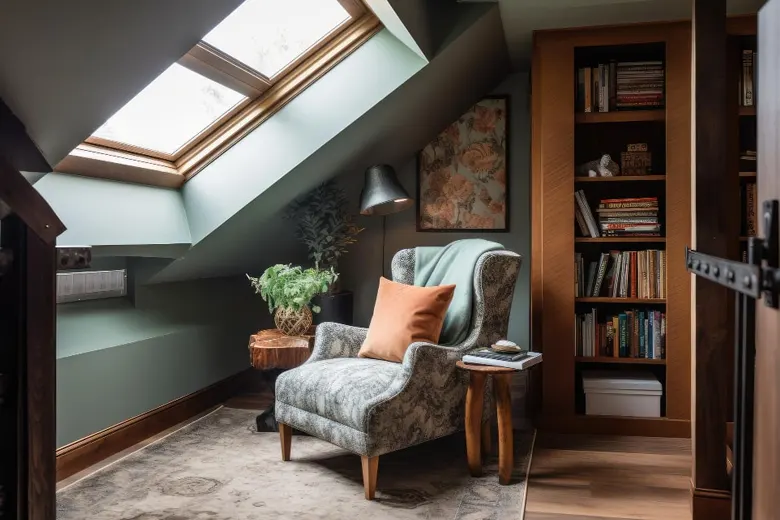
Image Courtesy: City Furnish
Working with small living rooms that come with slanted ceilings or odd angled walls can be a little tricky. Introducing a nook that fits these spatial constraints is a great way of approaching it. You can go with a comfortable armchair paired with a chic side table, add a lampshade, and have a reading corner in no time or consider lower lounging seats to make your room feel more spacious. Use lower ottomans as extra seating, adding to the cozy ambiance, and personalize this corner by hanging your favorite photographs or artwork.
8. Select a Large Area Rug
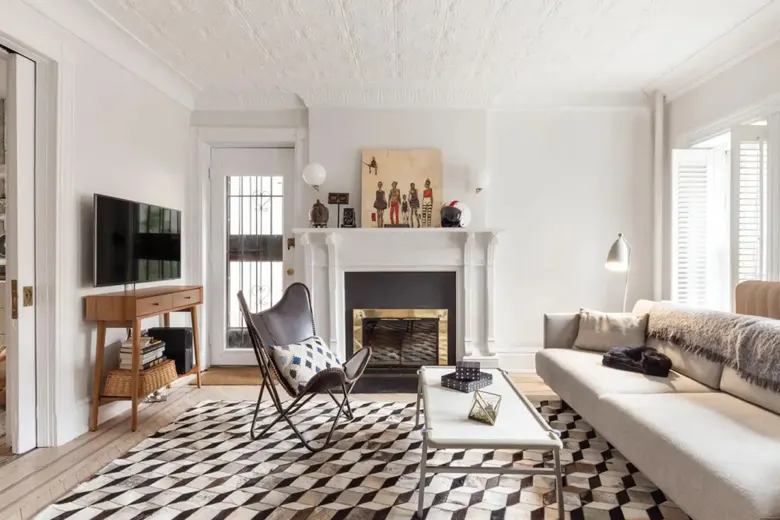
Image Courtesy: Good Housekeeping
While it may seem counterintuitive, opting for a larger area rug can actually make a small living room feel more spacious. By choosing a rug that adequately delineates the seating area from other functions in the room, you create the illusion of a larger living space. Unlike smaller rugs, a larger one adds structure to a small space and visually expands the length and width of the room. To ensure you choose the right size, make sure the rug is large enough to accommodate all furniture legs.
9. Maintain a Single Colour for Walls & Furniture
Using a single color for both the walls and woodwork ensures there is no contrast between elements, making boundaries less noticeable and the room much larger. The lack of interruption in color scheme allows the eye to focus less on the room dimensions and more on the overall appearance of the living room.
10. Choose Symmetry
If the architecture of your small living room allows you to pick symmetry, please do. It creates a sense of balance and order, which particularly works for smaller rooms. When furniture and decor pieces are arranged symmetrically, it prevents the room from feeling cluttered or disorganized. It also allows you to create a focal point, like a fireplace, a large window, or a statement furniture. Arrange your furniture and accessories around this focal point and create a cohesive look that draws the eye inward, making the space feel larger and more inviting.
11. Go Vertical
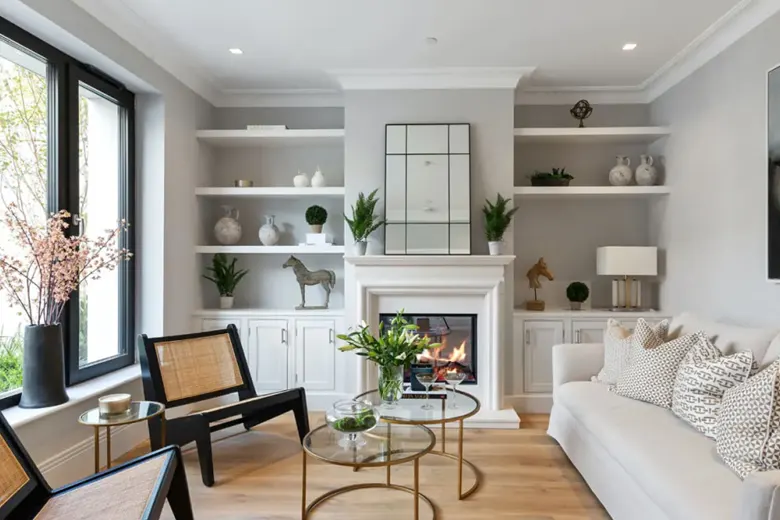
Image Courtesy: Unsplash
Pay attention to vertical elements, especially when decorating walls. Opt for arrangements that elongate the room, such as vertically hung frames, pictures, or paintings. Incorporate sconces, tall plants, and a narrow floor-to-ceiling bookcase to add height to your space. You can also consider using vertical striped wallpapers to add character and create the appearance of a higher ceiling.
12. Use Patterns & Textures As Accents
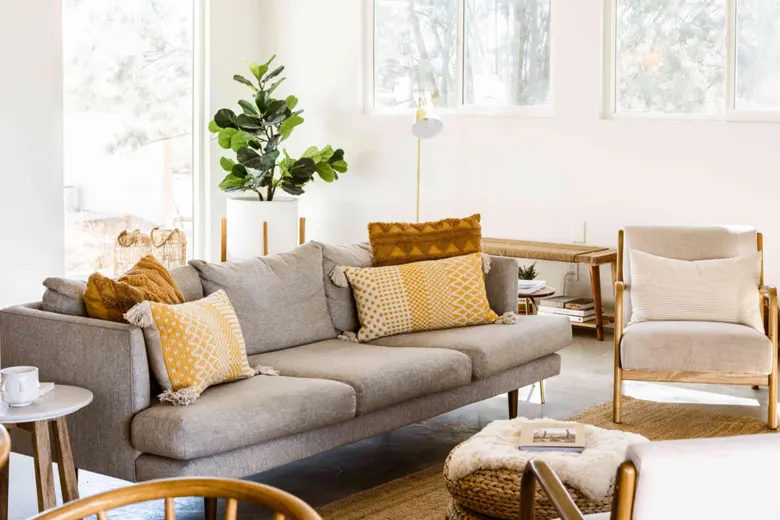
Image Courtesy: The Spruce
Don’t hesitate to embrace bold color, textures and patterns, especially when it comes to decorating a small living room. All you need is a well-coordinated and balanced scheme that includes textured floor rugs, patterned cushions, and printed throws to create a cozy and comfortable space. Unique artwork and vibrant accessories can also be used to create captivating scenes throughout the room, adding depth and visual interest.
13. Pick Light-Weight Curtains or Blinds
Opt for lightweight fabric curtains or install wooden blinds to allow more light into the room during the day while providing nighttime privacy. Choose white or neutral colors to maximize natural light reflection and avoid dark colors. Another trick is using floor-to-ceiling curtains that emphasize the room's height and accentuate its proportions.
14. Keep Your Room Organised
Organized spaces maximize the available space by eliminating clutter. Organize your room for better flow and ease of movement, and ensure a dedicated place for everything— storage units, built-in cabinets, and furniture with storage. Organization prevents visual chaos in a confined room, allowing elements to shine without distractions.
15. Opt for a Monochromatic Theme
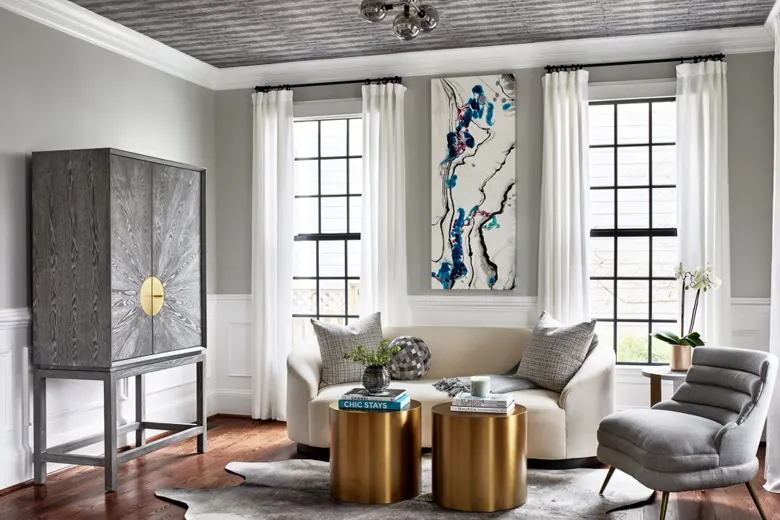
Image Courtesy: My Domaine
Using a monochromatic color theme with different tones of the same color can make furniture and features appear to recede. This visual continuity tricks the eye into perceiving the room as more open and spacious. The lack of contrasting colors prevents the room from feeling choppy or cramped. Additionally, monochromatic palettes, especially in lighter tones, can make a small living room appear brighter and airier.
16. Incorporate Stripes
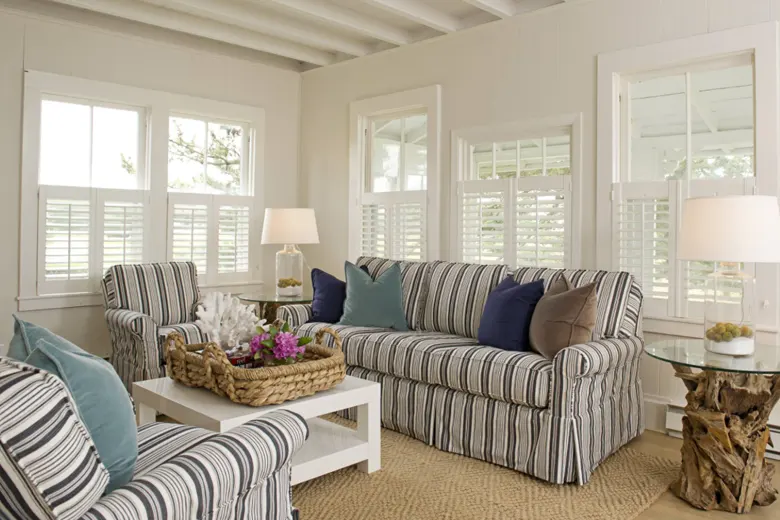
Image Courtesy: Houzz
Opting for stripes is an effective way of making small living rooms appear larger and more dynamic. The direction of the stripes creates distinct visual effects and adds character to your space—vertical stripes make a room look taller. This is particularly useful in rooms with low ceilings. Use vertical stripes on armchairs or curtains to extend the height throughout the room. On the other hand, horizontal stripes make a room appear wider or longer, which can make narrow rooms more spacious. If you’re using stripes on one element, balance the room with solid colors or smaller patterns on other furnishings to avoid overwhelming the space.
17. Use a Large Mirror
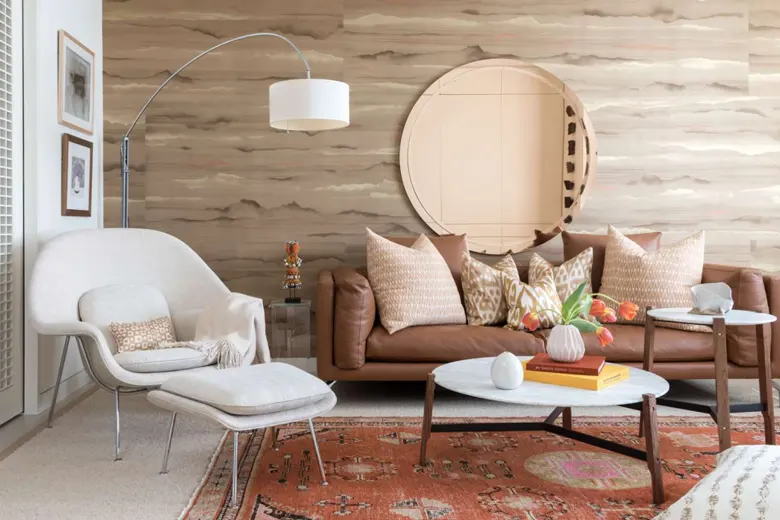
Image Courtesy: The Spruce
Strategically placed mirrors on walls can induce a sense of flow and create the illusion of a much larger room. Hang a large mirror, preferably on a wall opposite a window or at least near it. This will help reflect the outdoors and make your small living room feel broader. Mirrored cabinet doors can also do the same, making it feel expansive as well as organized.
18. Layer Your Lights
Combining different types of lighting at various levels and positions allows you to control the mood and perception of a space. Think floor lamps, chandeliers, pendant lights, task lights, and table lamps. Layer your lights and manipulate their placement to make your small living room larger and more inviting.
19. Go for Oversized Artwork
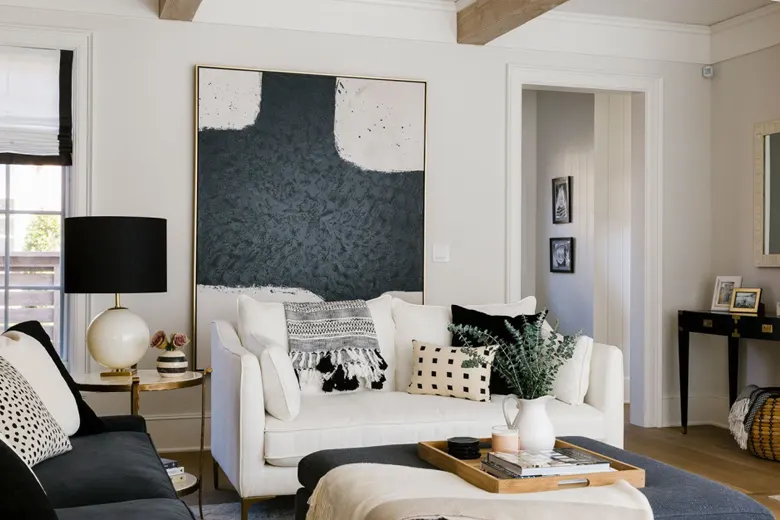
Image Courtesy: Havenly
An aesthetic gallery wall usually helps divert attention from the size of the room. Hang one or two oversized pieces of artwork and make your small living room more spacious. Avoid using small pieces, and do not hang them too high, as it can create an imbalance in the room’s proportions. Instead, position them slightly above the couch at eye level and make your room appear wider.
20. Pay Attention to Scale and Proportion
Choose furniture and decor pieces that are proportionate to the room size and play with varying scales for a balanced look. Avoid oversized sofas, cabinets and chairs that can make the space feel cramped. However, too many small pieces can also make the room seem smaller. Strike a balance by incorporating a few larger items, such as a large rug and a coffee table, paired with a compact sofa.
21. Combine Two Rooms
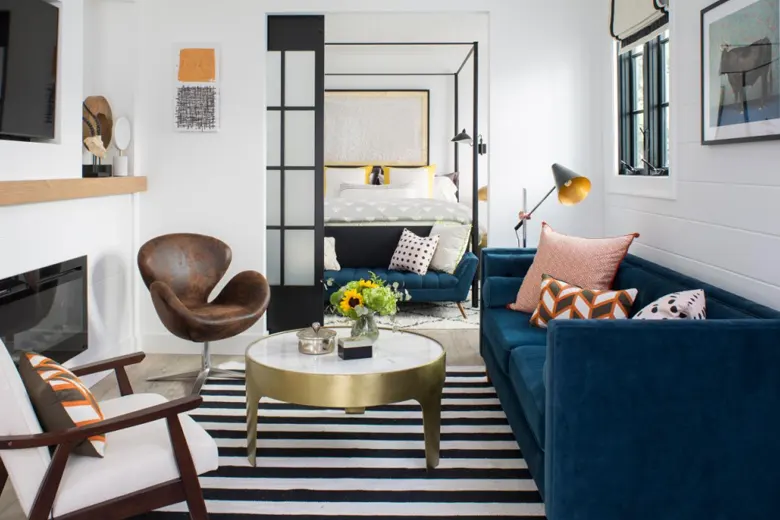
Image Courtesy: HGTV
If you have a narrow space divided into a living and a dining room, use a favourite color as a unifying theme to connect the two rooms and make your existing space more spacious. You can also arrange the furniture in such a way that both rooms appear to be part of the same space.
22. Balance Dark Colours With Light
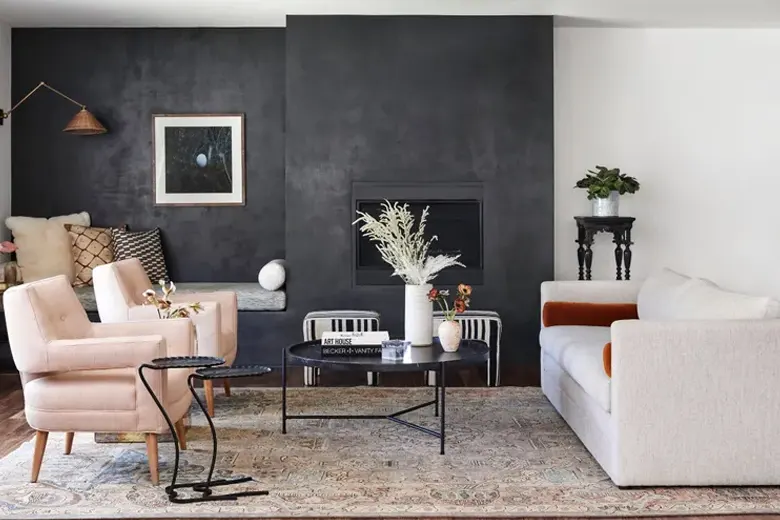
Image Courtesy: Homes & Gardens
If you have large windows facing south or west, you can go with a dark-colored accent wall and beyond. But while doing so, ensure that you create a contrast with paler shades on other walls and furnishings to avoid feeling confined. The idea is to achieve a good balance between light and dark colors. Keep the lighting soft and warm, and use wall lights or table lamps instead of spotlights, which can end up making the room feel uncomfortable.
23. Draw Attention To a Focal Point
Focal points create a visual anchor, pique interest, and define zones within a limited space, preventing the room from appearing too bland. Create a focal point with a statement furniture piece, an oversized artwork or even an accent wall and provide a unifying element around which the rest of the decor can be planned.
24. Pick a Statement Piece
Distract the eyes with one or two statement pieces, like an eye-catching couch, a bold lampshade, or a dramatic artwork. This adds contrast and character to the space and draws attention away from the actual room size.
25. Incorporate Soft Curves

Image Courtesy: House Beautiful
Choose elements with soft curves to balance the harsh angles of doorframes, windows, and other furniture items. An oval-shaped coffee table in wood with a glass top, round cushions, a circular jute rug, frames or even a couch with rounded edges can be a great option, making your small living room comfortable and inviting for socializing.
Conclusion and Next Steps
With that, we’ve come to the end of this holistic guide and hope we’ve inspired you to make the most of your small living rooms without the fear of missing out. If you follow the interior design principles and execute these practical and easy ideas, you can make your living room both comfortable and gorgeous, regardless of its size.
For more inspiration, check out this Residential Design Project by AND learner Aquib Khan, for instance, which utilizes key principles to deliver a design that closely aligns with the client’s needs.
In case you wish to learn more about interior design, here are some additional resources you can consider:
- Watch this session by Snehanshu Mukherjee, Founding Partner at T.E.A.M, and Mansi Almadi, an Interior Designer at Studio Lotus
- Talk to a course advisor to discuss how you can transform your career with one of our courses.
- Check out our Interior Design courses - all courses are taught through live, interactive classes by industry experts.
- Take advantage of our scholarship and funding options to overcome any financial hurdle on the path of your career transformation.
Note: All information and data from external sources are believed to be accurate as of the date of publication.

